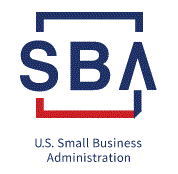SBA Loan Information
What is the SBA?
SBA is an abbreviation for the U.S. Small Business Administration. The SBA is a federal agency that was created in 1953 with a mission to help small businesses. It provides financial assistance, including SBA loans, as well as counseling and other types of support to small businesses.

Does my business qualify as "small" for an SBA loan?
The Small Business Administration defines "small" based on revenue and number of employees. The exact numbers to qualify as a small business vary by industry.
Qualifying as small is one of the basic requirements your business needs to meet before you can compete for government contracts that are set aside for small businesses.
You can find out if your business qualifies as small by contacting us or by referencing the SBA's table of small business size standards. Both the tool and the table help you find the small business classification requirements according to individual NAICS codes.
When we help you calculate the size of your business, you must include the annual receipts and the employees of your affiliates. When another person or business can control your business, they are an affiliate. This is true even if they don’t exercise their control.
General business size requirements
In addition to meeting the numerical standards for small, your business must:
-
Be a for-profit business of any legal structure
-
Be independently owned and operated
-
Not be nationally dominant in its field
-
Be physically located and operate in the U.S. or its territories
Businesses outside the U.S. may still be counted as small if they have an operation in the U.S. that makes a significant contribution to the U.S. economy through payment of taxes or use of American products, materials, or labor.

Interim Guidance
The following interim guidance may help prevent workplace exposures to acute respiratory illnesses, including COVID-19, in non-healthcare settings. The guidance also provides planning considerations if there are more widespread, community outbreaks of COVID-19.
Below are recommended strategies for employers to use now.
-
Actively encourage sick employees to stay home
-
Separate sick employees
-
Emphasize staying home when sick, respiratory etiquette and hand hygiene by all employees
-
Perform routine environmental cleaning
-
Advise employees before traveling to take certain steps
-
Check the CDC’s Traveler’s Health Notices for the latest guidance and recommendations for each country to which you will travel. Specific travel information for travelers going to and returning from designated countries with risk of community spread of Coronavirus, and information for aircrew, can be found on the CDC website.
-
-
Additional Measures in Response to Currently Occurring Sporadic Importations of the COVID-19:
-
Employees who are well but who have a sick family member at home with COVID-19 should notify their supervisor and refer to CDC guidance for how to conduct a risk assessment of their potential exposure.
-
If an employee is confirmed to have COVID-19, employers should inform fellow employees of their possible exposure to COVID-19 in the workplace but maintain confidentiality as required by the Americans with Disabilities Act (ADA). Employees exposed to a co-worker with confirmed COVID-19 should refer to CDC guidance for how to conduct a risk assessment of their potential exposure.
-

Common Issues Small Businesses May Encounter:
-
Capital Access – Incidents can strain a small business's financial capacity to make payroll, maintain inventory and respond to market fluctuations (both sudden drops and surges in demand). Businesses should prepare by exploring and testing their capital access options so they have what they need when they need it.
-
Workforce Capacity – Incidents have just as much impact on your workers as they do your clientele. It’s critical to ensure they have the ability to fulfill their duties while protected.
-
Inventory and Supply Chain Shortfalls – While the possibility could be remote, it is a prudent preparedness measure to ensure you have either adequate supplies of inventory for a sustained period and/or diversify your distributor sources in the event one supplier cannot meet an order request.
-
Facility Remediation/Clean-up Costs – Depending on the incident, there may be a need to enhance the protection of customers and staff by increasing the frequency and intensity by which your business conducts cleaning of surfaces frequently touched by occupants and visitors. Check your maintenance contracts and supplies of cleaning materials to ensure they can meet increases in demand.
-
Insurance Coverage Issues – Many businesses have business interruption insurance; Now is the time to contact your insurance agent to review your policy to understand precisely what you are and are not covered for in the event of an extended incident.
-
Changing Market Demand – Depending on the incident, there may be access controls or movement restrictions established which can impede your customers from reaching your business. Additionally, there may be public concerns about public exposure to an incident and they may decide not to go to your business out of concern of exposing themselves to greater risk.
-
Marketing – It’s critical to communicate openly with your customers about the status of your operations, what protective measures you’ve implemented, and how they (as customers) will be protected when they visit your business. Promotions may also help incentivize customers who may be reluctant to patronize your business.



